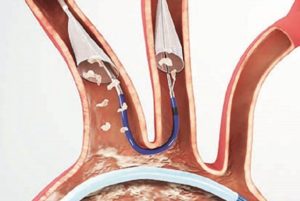 The National Institute for Health and Care Excellence (NICE) has released evidence-based recommendations on the percutaneous insertion of a cerebral protection device to prevent cerebral embolism during transcatheter aortic valve implantation (TAVI).
The National Institute for Health and Care Excellence (NICE) has released evidence-based recommendations on the percutaneous insertion of a cerebral protection device to prevent cerebral embolism during transcatheter aortic valve implantation (TAVI).
It says that the evidence on percutaneous insertion of a cerebral protection device to prevent cerebral embolism during TAVI raises no major safety concerns other than those associated with the TAVI procedure. However, the evidence on efficacy for preventing TAVI-related stroke is inconclusive, and the procedure should therefore only be used with “special arrangements” for clinical governance, consent, and audit or research. Clinicians wishing to percutaneously insert a cerebral protection device during TAVI should inform the clinical governance leads in their NHS trusts. They must ensure patients and their care providers understand the procedure’s safety and efficacy, as well as any uncertainties, and that they provide clear written information to support shared decision-making. Details of all patients should be entered into the UK TAVI registry.
NICE also suggests that patient selection should be by the multidisciplinary team, and the procedure should only be done in specialised centres, by clinicians and teams with specific training and experience. Centres doing this procedure should have both cardiac and vascular surgical support for the emergency treatment of complications and subsequent patient care.
NICE also encourages further research on percutaneous insertion of a cerebral protection device to prevent cerebral embolism during TAVI, to include details of patient selection and risk stratification for TAVI-related stroke, and says it may update its guidance on publication of further evidence.
According to the NICE guidance, the evidence review identified three types of cerebral protection devices. One is a deflector system that covers all three main branches of the aortic arch. The other two cover the brachiocephalic trunk and the left common carotid artery; one of these is a filter system and the other a deflector system.
The guidance will be reviewed again in June 2022, and a full outline of the recommendations is available on the NICE website.













